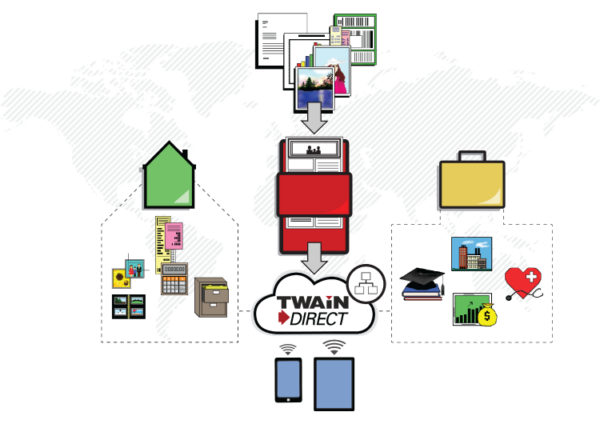
The market research firm Keypoint Intelligence recently published a blog about the potential impact of the COVID-19 pandemic on U.S. office print volumes in 2020. The picture it paints is not a pretty one.
The company is tracking different vertical industries and their contribution to office printing and has estimated best- and worst-case impacts on print. The two variables it used for estimating print reductions are job losses by vertical and print loss from working at home. The firm’s model estimated a two-month impact, which it says may be optimistic.
The biggest impact will be on the three verticals most impacted by job losses—retail trade, accommodation and food services (hotels and restaurants), and arts and entertainment. The best- and worst-case impact from those three verticals, according to Keypoint Intelligence are the elimination of from 12 to 24 billion pages from total U.S. office print volume.
The second biggest impact is on industries that have experienced modest job losses such as manufacturing, transportation and warehousing, administration and waste services, construction, other services, real estate and rental, and financial and insurance. Within these industries, estimated print reductions caused by job losses, range from 15 to 21 billion prints.
With more employees working remotely, this too will have an impact on print volume. These markets encompass education, professional services, information, management of companies, manufacturing, other services, financial and insurance, real estate and rental. The estimated decline in print volume resulting from working from home in the above verticals ranges from 24 billion to 47 billion pages.
The best- and worst-case impacts from job loss and working at home, for a potential two-month lockdown, the impact on the 2020 total U.S. print volume could see a loss of 10% or 80-million pages out of 837 billion.
After reading the Keypoint Intelligence blog, I interviewed John Shane, director, office technology & services communication supplies, about the firm’s frightening projections.
CR: I was looking at your projections for what may happen in the U.S. office printing space this year. How depressing did you find these projections?
Shane: Yeah, it was just a two-month look, and it even mentions that it may be optimistic. It’s like a snapshot. This is what could be.
CR: Did it surprise you after putting all the numbers together?
Shane: No. If you look at the 80 billion pages, which is the most likely loss for a two-month period, that’s about a 50% cut for a two-month period, which is the same as roughly a 10% cut for the year, is sensible to me. Now, we haven’t been able to get real field input yet on what the dealers may be seeing in terms of clicks.
CR: Looking at where you separate the losses by different verticals. The biggest impact is on retail, hotel and restaurants, and arts and entertainment. I didn’t realize these industries printed so many pages.
Shane: Each industry has their own total page volume in normal times. We have total pages by industry, and we looked at each one individually. And for this blog, grouped them by hard impact and modest impact.
CR: Are there any industries that may hold steady over this period? Healthcare comes to mind.
Shane: We actually did see an increase in printing from healthcare. We’re not predicting for it because it wasn’t one of the verticals that got seriously hit.
CR: Are there other industries you track that will be relatively stable during this two-month time frame?
Shane: Agriculture, utilities, those necessary services. Some are a mixed bag like transportation and warehousing. As you know, the trucks are still running to provide food. Amazon is up and running even more so now than before. But also included in that category is air travel.
CR: Looking at the big picture with the OEMs and dealers, do you think this is going to have an impact on MPS contracts?
Shane: Depending on how long this goes on, what will they do if the contract is up while everybody is under a “stay home” order? What do you think? I would think that they would do an ad hoc extension and decide later.
Some of the things that we could certainly see happening is that, depending on again, how long it goes on and how much of this becomes permanent, work-at-home for example, you could see a persistent shift away from larger equipment to more personal equipment. If some percentage of the people who are now working at home decide to stay at home, it’s a possibility. We’re not putting any numbers on that at this time. It’s reasonable to think that if more people are remotely working on a more permanent basis as we work our way out of this, there would be a shift. Dealers should make it easy to add or subtract work at home employees in the MPS contract.
CR: When things settle down and we’re not worried about COVID-19, and people get back to work, I’m thinking printing is going to decline faster than previously predicted before the pandemic, because printing habits have changed.
Shane: It’s certainly reasonable to suspect that there could be some permanent changes that would not have happened had this not happened.
CR: To illustrate the point here in my house, my partner is an architectural engineer and is typically working with large PDFs of architectural drawings. When she was in the office, she was printing those, marking them up, writing notes on them. Now that she’s working from home, that’s not happening and she’s realizing maybe she doesn’t need to do that anymore when she goes back to work in a traditional office.
Shane: Some of the research we’ve done in the past couple cycles have looked at knowledge workers and their print behavior. We’ve separated them based on what they identify different documents to be as whether they’re “optionally print” or “required print.” “Optional” is they print them because they prefer to read or edit or store on paper. It’s a personal preference. Then “required to print” is what does the current business process look like? It’s certainly a strong possibility that as people work at home they will scramble to find a digital way of doing things as opposed to paper processes. That could be a catalyst for a quickening shift away from paper in the business process.
CR: With prints on the decline, what are your thoughts as to what’s going to happen with all these toner companies whether they’re based in the U.S. or Asia and making original OEM products, clones, or compatibles?
Shane: By and large, at least up until now, most of the clone activity has been on the internet. Whereas the large contract stationers, the office equipment dealers, they’ve been a bit wary of these new build compatibles from China. They’ve been loyal to either OEM or a domestic manufacturer. We’re still working out to what extent you could expect this pandemic to change that dynamic. It looks like China is up and running again business wise so any issues related to shipping have passed. But there are probably some people with unfounded fears that something made in China, even though it took a month to come across the Pacific, might be contaminated.
That’s one of the things that is sort of a second or third order of how much this will really impact. The OEMs are saying that at this time their supply chain is functioning properly and they won’t have any shortages. I suspect that manufacturing of all three groups of products would not face shortages. It’s will the customers’ change in printing behavior cause a difference. We don’t know yet. People may become more price conscious and shift the ratio between OEM vs Reman vs New Build Compatible but it’s too early to see that. For example to the extent that work at home increases home print volume, will workers be able to expense their supplies or not? That may have an impact.
CR: I imagine a significant decline in print that could become permanent will have quite the impact on the OEMs who will have to rethink their R&D and their go-to market strategy with some of these traditional print-type products. What’s next for them?
Shane: Directionally, we think that this is going to cause a permanent change, both a shift in print location as well as speeding the move to digital.
CR: If I’m a dealer or an OEM reading your blog, is there anything I can do other than freak out?
Shane: Depending on how long it lasts, I would think that they would want to do what they can to help make working from home as seamless as working at the office. That may be providing all kinds of personal equipment. It may be providing MFPs for people who don’t have them. Maybe installing the applications that are needed in order to do something in a digital fashion that was done on paper previously. That may be ad-hoc initially.
Longer term, and after we are out from under the immediate crisis, to do it right, companies will likely want professional help. We don’t know at this time how many companies included a pandemic as part of their disaster plan. We suspect that many more companies will after this. They will need processes what will work whether at the office or at home or a remote location. The dealers really should be looking at that opportunity. And for good or bad it probably means less paper printed versus what would have happened had this pandemic never happened.
These are many of the issues we are looking at for our next, more detailed look at how this pandemic will change print volume.
Click here to read the Keypoint Intelligence blog.
Access Related Content
Visit the www.thecannatareport.com. To become a subscriber, visit www.thecannatareport.com/register or contact cjcannata@cannatareport.com directly. Bulk subscription rates are also available.




